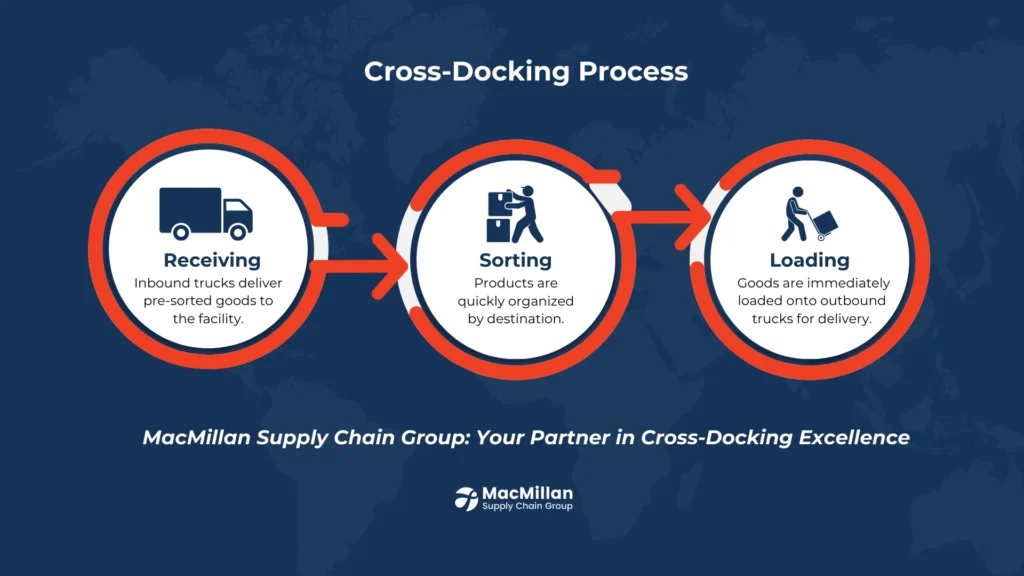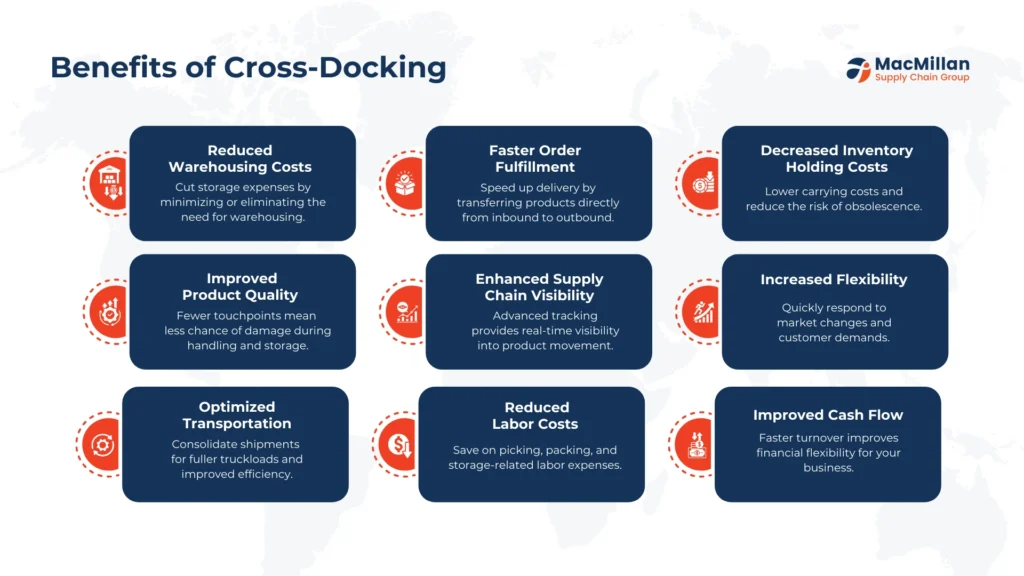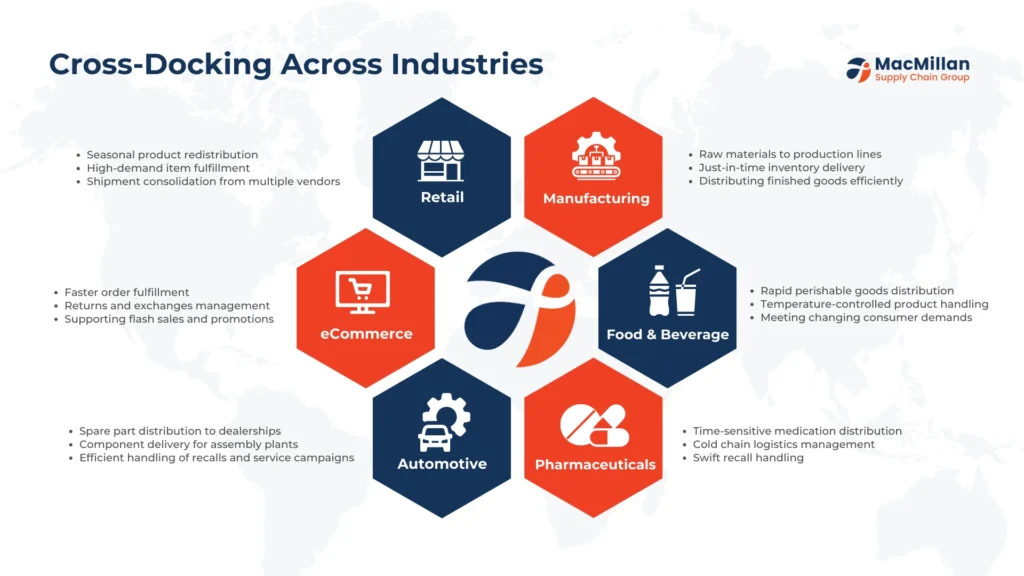A quick summary and overview
Cross-docking is a game-changing logistics strategy that eliminates the need for warehouse storage, moving products directly from inbound to outbound transportation. This innovative approach significantly reduces handling time, storage costs, and order fulfillment cycles. At MacMillan Supply Chain Group, we specialize in implementing cross-docking solutions that optimize your supply chain, enhance customer satisfaction, and boost your bottom line. Whether you’re in retail, manufacturing, or eCommerce, our tailored cross-docking services can revolutionize your logistics operations. Discover how this powerful technique can transform your business and give you a competitive edge in today’s fast-paced market.

An introduction
In today’s rapidly evolving business landscape, staying ahead of the competition means constantly seeking ways to optimize your supply chain. Enter cross-docking – a revolutionary logistics strategy that’s transforming the way companies handle their inventory and fulfill orders. But what exactly is cross-docking, and how can it benefit your business?
Cross-docking is the practice of unloading materials from incoming trucks or rail cars and loading these materials directly into outbound trucks, trailers, or rail cars, with little or no storage in between. This process eliminates the need for warehouse storage, reducing handling time and costs while speeding up the order fulfillment process.
At MacMillan Supply Chain Group, we’ve mastered the art of cross-docking, helping businesses across various industries streamline their operations, reduce costs, and improve customer satisfaction. In this comprehensive guide, we’ll explore the ins and outs of cross-docking, its benefits, and how you can implement this powerful strategy in your own supply chain.
Understanding the Basics of Cross-Docking
Cross-docking is a logistics practice that focuses on the quick distribution of goods with minimal handling and storage time. The process typically involves these key steps:
- Receiving: Inbound trucks arrive at the cross-docking facility with pre-sorted goods.
- Sorting: Products are quickly sorted based on their final destination.
- Loading: Goods are immediately loaded onto outbound trucks for delivery.
There are two main types of cross-docking:
- Pre-distribution cross-docking: Products are allocated to specific customers before arriving at the cross-dock facility.
- Post-distribution cross-docking: Products are sorted and allocated at the cross-dock facility based on real-time demand.
Cross-docking is particularly effective for:
- Perishable goods that require quick distribution
- High-demand products with predictable sales patterns
- Promotional items or seasonal merchandise
- Pre-packaged orders for specific customers
By eliminating the need for long-term storage and reducing handling time, cross-docking can significantly improve supply chain efficiency. It’s especially valuable in industries where speed and precision are crucial, such as retail, manufacturing, and eCommerce fulfillment.
At MacMillan Supply Chain Group, we tailor our cross-docking solutions to meet the unique needs of each client, ensuring optimal results regardless of industry or scale of operations.

The Benefits of Implementing Cross-Docking
Implementing a cross-docking strategy in your supply chain can yield numerous benefits:
- Reduced Warehousing Costs: By minimizing or eliminating the need for storage, cross-docking can significantly reduce warehousing expenses.
- Faster Order Fulfillment: Direct transfer from inbound to outbound transportation speeds up the delivery process, reducing lead times and improving customer satisfaction.
- Decreased Inventory Holding Costs: With less inventory stored, you’ll see a reduction in carrying costs and the risk of obsolescence.
- Improved Product Quality: Fewer touch points mean less chance of damage during handling and storage.
- Enhanced Supply Chain Visibility: Cross-docking facilities often utilize advanced tracking systems, providing real-time visibility into product movement.
- Increased Flexibility: Cross-docking allows for quicker responses to market changes and customer demands.
- Optimized Transportation: By consolidating shipments, cross-docking can lead to fuller truckloads and more efficient transportation.
- Reduced Labor Costs: With less need for picking, packing, and put-away activities, labor costs can be significantly reduced.
- Improved Cash Flow: Faster inventory turnover means improved cash flow for your business.
At MacMillan Supply Chain Group, we’ve helped numerous clients realize these benefits through our expertly designed and implemented cross-docking solutions. Our tailored approach ensures that you maximize the advantages of cross-docking for your specific business needs.
Implementing Cross-Docking in Your Supply Chain
Successfully implementing cross-docking requires careful planning and execution. Here are key steps to consider:
- Assess Your Current Operations: Evaluate your existing supply chain to identify areas where cross-docking could be beneficial.
- Choose the Right Products: Not all items are suitable for cross-docking. Select products with consistent demand and those that don’t require special handling.
- Invest in Technology: Implement a robust Warehouse Management System (WMS) to coordinate incoming and outgoing shipments efficiently.
- Design Your Facility: Create a layout that facilitates smooth product flow from inbound to outbound docks.
- Train Your Staff: Ensure your team understands the cross-docking process and can execute it efficiently.
- Establish Strong Partnerships: Work closely with suppliers and carriers to coordinate timely deliveries and pickups.
- Implement Quality Control Measures: Despite the speed of cross-docking, maintain rigorous quality checks to ensure accuracy.
- Monitor and Optimize: Continuously analyze your cross-docking operations and make adjustments for optimal performance.
- Consider Starting Small: Begin with a pilot program to test and refine your cross-docking processes before full-scale implementation.
At MacMillan Supply Chain Group, we guide you through each of these steps, leveraging our expertise to ensure a smooth transition to cross-docking. Our comprehensive approach covers everything from initial assessment to ongoing optimization, helping you maximize the benefits of this powerful logistics strategy.

Cross-Docking in Different Industries
Cross-docking has proven valuable across various industries, each with its unique applications:
Retail:
– Quickly move seasonal products to stores
– Efficiently distribute high-demand items
– Consolidate shipments from multiple vendors
Manufacturing:
– Streamline the flow of raw materials to production lines
– Quickly distribute finished products to customers
– Manage just-in-time inventory more effectively
eCommerce:
– Speed up order fulfillment for fast-moving products
– Efficiently handle returns and exchanges
– Manage flash sales and promotional events
Food and Beverage:
– Ensure rapid distribution of perishable goods
– Manage temperature-controlled products effectively
– Quickly respond to changing consumer demands
Automotive:
– Efficiently distribute spare parts to dealerships
– Manage just-in-time delivery of components to assembly plants
– Handle recalls and service campaigns effectively
Pharmaceuticals:
– Ensure rapid distribution of time-sensitive medications
– Manage cold chain logistics efficiently
– Handle product recalls quickly and effectively
At MacMillan Supply Chain Group, we understand the nuances of cross-docking in different industries. Our team of experts works closely with you to develop industry-specific cross-docking solutions that address your unique challenges and maximize your competitive advantage.
Common problems with cross-docking and Our solutions
While cross-docking offers numerous benefits, it’s not without its challenges. Here are some common problems and how MacMillan Supply Chain Group addresses them:
Coordination Complexity:
Problem: Cross-docking requires precise timing and coordination between inbound and outbound shipments.
Solution: We implement advanced scheduling systems and real-time communication tools to ensure seamless coordination. Our team of experts manages the entire process, acting as a central point of contact to streamline operations.
Technology Integration:
Problem: Effective cross-docking requires sophisticated technology that many companies struggle to implement.
Solution: MacMillan Supply Chain Group offers state-of-the-art Warehouse Management Systems (WMS) tailored to your needs. We handle the integration process, ensuring your systems work seamlessly with our cross-docking operations.
Space Constraints:
Problem: Cross-docking facilities require specific layouts that can be challenging to design and implement.
Solution: Our team of logistics experts designs optimal cross-docking facilities, maximizing space utilization and product flow. We can either optimize your existing space or help you find and set up a new facility tailored to cross-docking operations.
Quality Control:
Problem: The speed of cross-docking can sometimes lead to errors or quality issues.
Solution: We implement rigorous quality control measures, including barcode scanning and automated checks, to ensure accuracy without sacrificing speed. Our trained staff is vigilant in maintaining quality standards throughout the process.
Demand Fluctuations:
Problem: Unexpected changes in demand can disrupt cross-docking operations.
Solution: MacMillan Supply Chain Group employs advanced forecasting tools and flexible staffing models to adapt quickly to demand fluctuations. We work closely with your team to anticipate changes and adjust operations accordingly.
Supplier Reliability:
Problem: Cross-docking relies heavily on timely deliveries from suppliers.
Solution: We establish strong relationships with reliable carriers and implement performance tracking systems to ensure consistent, on-time deliveries. Our team works proactively to address any potential delays or issues.
Product Mix Complexity:
Problem: Managing a diverse product mix can complicate cross-docking operations.
Solution: Our sophisticated sorting systems and trained staff efficiently handle diverse product mixes. We develop customized processes for each client to ensure all products are handled appropriately.
Scalability:
Problem: As businesses grow, scaling cross-docking operations can be challenging.
Solution: MacMillan Supply Chain Group’s solutions are designed with scalability in mind. We continuously assess your needs and adjust our operations to accommodate your growth, ensuring your cross-docking strategy evolves with your business.
By partnering with MacMillan Supply Chain Group, you gain access to our wealth of experience in overcoming these common cross-docking challenges. Our comprehensive solutions ensure that you can fully leverage the benefits of cross-docking while minimizing potential pitfalls.
How can reader avoid problem or implement solution
To successfully implement cross-docking and avoid common pitfalls, consider the following steps:
- Conduct a thorough assessment of your current supply chain to identify areas where cross-docking can add value.
- Invest in robust technology systems that can handle the complexities of cross-docking operations.
- Train your staff extensively on cross-docking procedures and best practices.
- Establish strong relationships with reliable suppliers and carriers to ensure timely deliveries.
- Implement rigorous quality control measures to maintain accuracy and product integrity.
- Regularly review and optimize your cross-docking processes to ensure maximum efficiency.
- Stay flexible and be prepared to adjust your strategy as your business grows and market conditions change.
While these steps can help you get started, implementing an effective cross-docking strategy can be complex and challenging. That’s where MacMillan Supply Chain Group comes in. Our team of experts has years of experience in designing and implementing successful cross-docking solutions across various industries.
Don’t let the complexities of cross-docking hold your business back. Partner with MacMillan Supply Chain Group today and transform your supply chain. Our tailored solutions, cutting-edge technology, and industry expertise will help you overcome challenges and maximize the benefits of cross-docking.
Contact us now for a free consultation and discover how we can revolutionize your logistics operations with cross-docking. Let’s work together to streamline your supply chain, reduce costs, and boost your competitive edge in today’s fast-paced market.
FAQs
Cross-docking is a logistics practice where products are transferred directly from inbound to outbound vehicles with minimal or no storage in between. This process significantly reduces handling time and storage costs.
Solution: MacMillan Supply Chain Group can implement a tailored cross-docking system that fits your specific business needs, optimizing your supply chain and reducing costs.
Traditional warehousing involves storing products for extended periods, while cross-docking focuses on immediate transfer of goods, minimizing storage time.
Solution: We can help you transition from traditional warehousing to cross-docking, or implement a hybrid model that combines both approaches for maximum efficiency.
Products with stable demand, perishable goods, and pre-sorted or pre-packaged items are ideal for cross-docking.
Solution: Our team can analyze your product mix and help identify which items are best suited for cross-docking in your specific operation.
By eliminating storage and reducing handling time, cross-docking can significantly speed up the order fulfillment process.
Solution: MacMillan Supply Chain Group can design a cross-docking system that optimizes your order fulfillment process, reducing lead times and improving customer satisfaction.
Advanced Warehouse Management Systems (WMS), barcode scanners, and real-time tracking systems are crucial for efficient cross-docking.
Solution: We provide and integrate state-of-the-art technology solutions tailored to your cross-docking needs.
Cross-docking can reduce inventory levels and associated carrying costs by minimizing storage time.
Solution: Our experts can help you implement a cross-docking strategy that optimizes your inventory management, improving cash flow and reducing obsolescence risk.
Yes, cross-docking can be adapted to businesses of all sizes, though the implementation may differ.
Solution: MacMillan Supply Chain Group offers scalable cross-docking solutions suitable for businesses of all sizes, from small startups to large enterprises.
Cross-docking can reduce transportation costs by enabling consolidation of shipments and more efficient route planning.
Solution: We can help optimize your transportation network in conjunction with cross-docking to maximize cost savings.
Common challenges include coordinating timing, managing diverse product mixes, and ensuring quality control.
Solution: Our experienced team can guide you through these challenges, implementing robust systems and processes to ensure smooth cross-docking operations.
Implementation time varies depending on the complexity of your operations and the scale of the change.
Solution: MacMillan Supply Chain Group offers phased implementation plans, allowing you to gradually transition to cross-docking while minimizing disruption to your current operations. Contact us today to discuss a timeline tailored to your needs.
